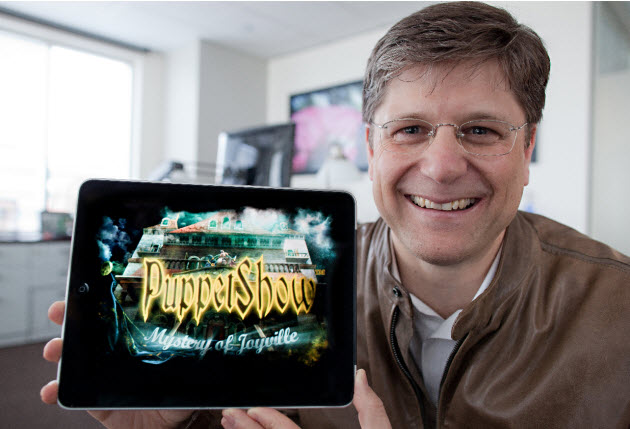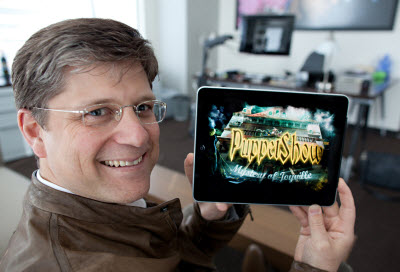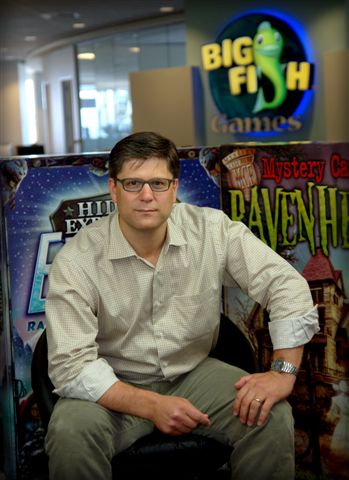 Big Fish Games is one of the stalwarts of casual games, with more than $100 million in revenues and steadily growing profits. Jeremy Lewis, chief executive of the Seattle-based company, has watched a lot of disruption in the game business with the growth of social games on Facebook and the rise of companies such as Zynga.
Big Fish Games is one of the stalwarts of casual games, with more than $100 million in revenues and steadily growing profits. Jeremy Lewis, chief executive of the Seattle-based company, has watched a lot of disruption in the game business with the growth of social games on Facebook and the rise of companies such as Zynga.
But he isn’t worried that the new social game startups will send Big Fish to the bottom of the sea. Big Fish is still pretty big in casual game web sites — with well over 1 billion downloads of its games since 2002 — and it is making a big move into smartphone and tablet games. In the fall of 2008, Big Fish Games raised $83 million, just before the financial crisis hit. It seemed like Big Fish would start an acquisition spree, much like rival Zynga.
But none of Big Fish’s growth has come from acquisitions (it actually on made one small acquisition). In fact, it hasn’t touched that cash, in what may be an example of rare patience on the part of a leader who wants his company to grow. While the social gaming Gold Rush has gone on around him, Lewis has patiently expanded his business at double-digit rates in an organic way. And he has 500 employees, including more than 100 that develop the company’s own games.
We caught up with Lewis at the Game Developers Conference. Here is an edited transcript of the interview.
 VB: What’s your outlook now?
VB: What’s your outlook now?
JL: During 2011 and 2012, we plan to scale the franchise of Big Fish Games in new directions. Mobile is a very natural extension to the casual game market where we already are. In particular, we are going to be active in the tablet market.
VB: What is your reaction to all of the industry events that are shaping the game industry now? We’ve seen Disney acquire social game maker Playdom and mobile game maker Tapulous. Then it turned the management team inside out, putting the social game people in charge of the overall game division. That’s a very big event in the industry. In the past couple of years, there’s been a lot of change like that.
JL: There has always been change, right? And there have always been trends and currents and waves that have come and have gone, and some have stayed and some have not. So we tend to take a longer-term view, and we tend to be a company that is very focused as the category leader in casual games on the PC and the Mac platforms. We are now testing and investing and scaling up the business in mobile. We will continue to test and invest in areas as they surface. Social is one of those areas, and we will take what we learn from that. But we will continue to focus on ensuring that as a developer and as a publisher, both businesses in which Big Fish Games is already at scale in, we will focus on revenue growth. We will continue to invest in both those areas in a way that ensures we are continuing to build goodness for developers and goodness for consumers. That’s really a focus that’s been a hallmark of our company since its founding.
VB: Does it seem like there is more opportunity now in mobile and social purely on Facebook?
JL: I can speak more specifically about mobile because we are active there. We have a little presence in social. There is a proliferation of platforms and the introduction of new distribution channels. When that happens, the overall market usually expands and so does the overall audience. Both emerging and developed markets benefit as that audience expands. It is the category leaders in each of these segments — casual, mobile, social networking — that will earn the lion’s share of the revenues in each market where they participate. That’s our belief, and that is what we are experiencing today. So we are glad that the industry is growing and our franchise will benefit from that.
 VB: Zynga has come to dominate social games on Facebook. It is an upstart that is leading a new market and it has stayed in the lead. Is that unusual?
VB: Zynga has come to dominate social games on Facebook. It is an upstart that is leading a new market and it has stayed in the lead. Is that unusual?
JL: I think that is consistent with how these markets actually are formed. In the early stages of a market and then over the course of time, it seems to me that those markets more often change in ways that allow new entrants to establish themselves. So Zynga’s leadership is not a surprise to me.
VB: The speed with which it has grown has caught a lot of people by surprise. They got to large-scale growth in a very short time.
JL: They’ve got the benefit of the internet’s growth and Facebook’s growth.
VB: Are the conditions for speedy growth ripe in mobile?
JL: Yeah. I think that’s right. The iPad is a very good example of that. It has created the conditions to capitalize on games for mobile devices that are very similar to what we are already doing on the web. Without a device like this, the opportunity wouldn’t be there.
 VB: So your shift into mobile is not a rethinking, but an extension?
VB: So your shift into mobile is not a rethinking, but an extension?
JL: It’s a natural change. That’s the best way I can explain it. We make highly replayable games. We make them in our own studio and we are working with other independent game development partners. We build games that are linear in storytelling and are very deep and immersive experiences.
VB: What would you consider to be a new category? I wrote about Her Interactive’s new Nancy Drew game, which is part game and part eBook. Is that a new category?
JL: I think there are a variety of derivative structures of games. One thing that hasn’t changed from the consumer’s perspective is that linear story-based games are consumable. You make one book-like game and then you move on to the next one. Then you have a series of episodes. There are lots of parallels between consumer consumption of books and linear games that are episodic in nature. This kind of episodic game is a hallmark of our company.
 VB: So if you buy one of these games and you get all the way through it, you are likely to buy the next five?
VB: So if you buy one of these games and you get all the way through it, you are likely to buy the next five?
JL: Indeed. We were a launch partner with Apple on the iPad. We created Hidden Expedition: Amazon (pictured right), for that platform. That was the third Hidden Expedition game in that series.
VB: So you have said you are very focused. When the industry changed and everybody started acting very quickly to change their businesses, what did you think? How did you look at it when some of these new things came into the industry and everybody started acting very quickly to change their businesses and strategies. People call it the Gold Rush.
JL: Sure, sure.
VB: Go buy your picks and shovels, right?
JL: Right. We are an analytical company. We test and invest very actively. We haven’t spent our money.
 VB: You raised a lot of money. That gave you a lot of advantages.
VB: You raised a lot of money. That gave you a lot of advantages.
JL: In 2008, yeah.
VB: And yet you have not gone out and bought a big social game company or a bunch of little ones. Why are you on a different path?
JL: That is a good question because 100 percent of our growth has been organic, which is unique in the game industry when you look back over the course of time. 100 percent of our growth has been organic since inception, and we continue to experience hyper growth. So we certainly benefited from that focus. And this goes back to categories. The PC and the Mac platforms are very big categories and continue to be very substantial market opportunities. Last year, we made investments in expanding our direct-to-consumer footprint there. We expanded to five new languages and 12 new currency payment options so we could reach 300 million more users. The growth has been terrific.
Our Japanese portal, for example, continues to grow very rapidly with very attractive conversion rates (consumers moving from a trial to a purchase) and the pool of independent developers that we work with to address those markets has been growing. Those two things were our best indication that we have a healthy and fast-growing market. It sustains our investment and attracts the attention of an ever-growing population of very talented and creative developers. They increasingly work with us on an exclusive basis. They look at our presence online. More than 50 percent of the content we release is exclusive to Big Fish Games. We focus on growing organically because that is where the growth has been and where it is now. It’s as simple as that. We are constantly testing and investing. We are very regularly approached by folks to entertain dialogues around merger and acquisition activities. It is always an option.
VB: Your revenues are in excess of $100 million.
JL: Well in excess.
VB: Has the financial industry in some way sort of not paid attention to that? Has it not noticed that revenue is there?
JL: I don’t know.
 VB: Zynga is reportedly valued at $10 billion. That’s all everybody seems to talk about. That may feel a little weird.
VB: Zynga is reportedly valued at $10 billion. That’s all everybody seems to talk about. That may feel a little weird.
JL: Well, Zynga has done a nice job of scaling a franchise in games on social networks, which is the most recent evolution and expansion of the audience for games. You will find that we and other category leaders will begin to capitalize on the market expansion that is being created by both smartphones and tablets.
VB: Do you have a reaction to the iPad 2?
JL: It’s a great device, and we will continue to work with our development partners and internal studio to bring our catalog of games to these devices in a very native way, which will delight customers. Apple will continue to delight customers. What do you think?
VB: If the graphics on it are nine times better, then it seems like your budget for graphics has to go way up?
JL: As you know, you can develop a game with intergalactic graphics capabilities that nobody buys, or you can develop a game that is very simple and yet is very addictive. The consumers will vote for what makes sense. Developers can use the high-end features of the iPad 2, but by no means are they forced to do so.
VB: It seems like the game production values are rising in this category. Is it similar to the arms race that happened on the PC and the consoles in terms of graphics?
JL: We didn’t experience that arms race, and I don’t expect to experience it here. Again, you can make highly addictive games for low budgets and you can also make large-budget games that can be very successful. I think the key is to ensure that as we scale our business, we are very careful not to have a concentration of hits. So in 2010, the highest concentration of revenue for any one brand or intellectual property was 1.6 percent. If you contrast that with other companies, you will find that that’s attractive. With our subscription game business, that gives us a consistency and visibility for our financial performance.
VB: But I guess when you get something like Angry Birds, you run with it?
JL: Sure, sure.
VB: That would be a nice problem to have, to be dependent on Angry Birds sales.
JL: But again, it’s a hit. We have hits. But we have a portfolio approach to the business. We release at least one new game every day across 10 languages. When you do that, you don’t tend to have volatility in your growth patterns. You reduce volatility and you increase visibility. The other thing I would say is that we always address the mass casual audience with those games. We have terabytes of data to tell us what delights customers on the internet. When people come to know and trust a brand on the internet, they spend more time with it. That drives our subscription business.
VB: Besides the iPad and the iPhone, what else is appealing to you as far as platforms to go?
JL: It comes back to focus, we have a very good relationship with Google, and we will be testing and investing in the Android market together with them. At the same time we are going to remain very focused and work closely with Apple to ensure that we are bringing best of breed premium casual content to iOS. I am most excited how the in-app purchase business model on the iPhone is so similar to the model we use on the web. We have been using “try before you buy” since the day we were founded.
VB: Yes, but people are more excited about doing micro-transactions (purchasing virtual items for very small amounts) rather than buying an entire game for a larger amount of money.
JL: I think there will be both models and you will see that. We have games with both models in place.
 VB: Do the other platforms have to prove themselves before you would start investing in them? There is Microsoft, RIM’s PlayBook, WebOS and others.
VB: Do the other platforms have to prove themselves before you would start investing in them? There is Microsoft, RIM’s PlayBook, WebOS and others.
JL: You will find that consistent with what we’ve done in the past. We will test and invest with each.
VB: Again, some people are in a rush. What is the right pace for testing and investing? DeNA bought Ngmoco for $403 million because they are in a rush. They feel like we will see billion-dollar companies emerge in the mobile game market. If you want to be one of them, you have to invest faster. That is the thinking.
JL: I would say the demographic trends are providing such favorable winds at our backs. Established developers are coming to Big Fish Games, and we think that will continue. There are roughly 300 million people in the U.S. and roughly 84 million of those are between the ages of 46 and 64. That is the sweet spot of the mass casual market. We are finding that early adopters of new devices are typically younger and more affluent. More than 70 percent of our market is female. They are buying these tablet devices and the games are becoming more viral. They go on a road trip and pass the tablet back to the kids, who play the casual games that are installed on the devices. We have an inter-generational dynamic going. That means that the kids who are playing only hardcore games are getting exposed to casual games by their parents. They will play games like Mahjong, Fairway Solitaire, Mystery Case Files (pictured above) and Drawn. When we invest, we do it in recognition of these trends.
 VB: If you look at a game like Drawn (pictured right) on the PC and on mobile, what do you notice that is different about the user?
VB: If you look at a game like Drawn (pictured right) on the PC and on mobile, what do you notice that is different about the user?
JL: We always focus on doing the highest quality games. We are creating a premium brand. It is very important for us to do games that are native for a given platform. They must be designed for the device. Not all strong branded games lend themselves to every device. So we curate our catalog and work with the best independent developers to bring new content to the market. We think very carefully about what works in a way that will delight the user. In making games for the iPad, we will do something like take advantage of its ability to be a great multiplayer device.
VB: Trip Hawkins (chief executive at Digital Chocolate) talked about the downside of mobile in a rant session. There are 350,000 apps on the iPhone, and they’ve generated $2 billion in revenues. That means the average revenue for an app is $5,000 or so. When you look at it that way, the iPhone is a horrible market.
JL: What did he recommend as a solution?
VB: He didn’t get that far.
JL: I can’t speak directly to what he said, Dean, but what I will tell you is that, ultimately quality prevails, and ultimately discovery is solved by consumers who are increasingly sophisticated across each of these platforms and ultimately determined to find what they love and vote with their wallets. That’s been our experience on the PC, and that’s been our experience on the Mac. That’s been our experience on mobile so far and in every geography where we operate. In the next 24 hours, users will download roughly two million games.
VB: So you are happy to live with the market forces on mobile?
JL: Oh yeah. Each of these innovations and new platforms and new channels are catalysts for growth.
VB: How are you doing at recruiting developers in the context of all this transformation, change or disruption going on?
 JL: Well, just as consumers are smart, so too are developers. We as a company have our roots in development from the very first year of our existence. So we continue to run a studio. We have more than 100 people in our development studio now, and we have a lot of independent developers. They work with publishers who over the course of time honor their work and treat them well.
JL: Well, just as consumers are smart, so too are developers. We as a company have our roots in development from the very first year of our existence. So we continue to run a studio. We have more than 100 people in our development studio now, and we have a lot of independent developers. They work with publishers who over the course of time honor their work and treat them well.
VB: A lot of the traditional console game companies are shifting from physical sales to digital platforms now. That’s a lot of new competition.
JL: I think that is the case across any industry, not just this one. But I think companies need to honest with themselves and determine whether they have the ability to make these changes, given their intrinsic skills. Can they execute on a big transition? We are very analytical and very thoughtful about how we invest our capital and how we invest our time. Because we are both a large developer and because we are a large distributor, we have a lot of creativity and lot of analytics.
We are able to leverage that creativity and the analytics so we get a daily awareness of consumer preferences. We have direct-to-consumer relationships and a high velocity of game launches. We take our insight and share it with developers so they can design the right games for the market. Before we release a game, we can determine the likely long-term revenues of that game with a low error margin.
 Calling all mobile executives: This April 25-26, VentureBeat is hosting its inaugural VentureBeat Mobile Summit, where we’ll debate the five key business and policy challenges facing the mobile industry today. Participants will develop concrete, actionable solutions that will shape the future of the mobile industry. The invitation-only event, located at the scenic and relaxing Cavallo Point Resort in Sausalito, Calif., is limited to the top 180 mobile executives, investors and policymakers. Request an invitation.
Calling all mobile executives: This April 25-26, VentureBeat is hosting its inaugural VentureBeat Mobile Summit, where we’ll debate the five key business and policy challenges facing the mobile industry today. Participants will develop concrete, actionable solutions that will shape the future of the mobile industry. The invitation-only event, located at the scenic and relaxing Cavallo Point Resort in Sausalito, Calif., is limited to the top 180 mobile executives, investors and policymakers. Request an invitation.
VentureBeat's mission is to be a digital town square for technical decision-makers to gain knowledge about transformative enterprise technology and transact. Learn More
